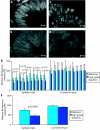Telomere shortening of epithelial cells characterises the adenoma-carcinoma transition of human colorectal cancer
- PMID: 12912862
- PMCID: PMC1773793
- DOI: 10.1136/gut.52.9.1304
Telomere shortening of epithelial cells characterises the adenoma-carcinoma transition of human colorectal cancer
Abstract
Background: and aims: Chromosomal instability is one of the most consistent markers of sporadic colorectal cancer in humans. There is growing evidence that telomere shortening is one of the mechanisms leading to chromosomal instability and cancer initiation.
Methods: To test this hypothesis, the telomere length of colorectal epithelial cells and cells from connective tissue was determined at the adenoma-carcinoma transition at the cellular level by quantitative fluorescence in situ hybridisation.
Results: Our study showed that the telomere fluorescence intensity of epithelial cells was significantly weaker at the earliest morphologically definable stage of carcinoma-high grade dysplasia with minimal invasive growth-compared with the surrounding adenoma. In contrast, cells from connective tissue had a similar telomere signal intensity at the carcinoma stage compared with the adenoma, and in turn cells from connective tissue had overall significantly stronger telomere fluorescence signals compared with epithelial cells.
Conclusions: These results demonstrate that short telomeres of epithelial cells characterise the adenoma-carcinoma transition during human colorectal carcinogenesis, suggesting that carcinomas arise from cells with critical short telomeres within the adenoma. Since the adenoma-carcinoma transition in colorectal cancer is characterised by an increase in chromosomal instability and anaphase bridges, our data support the hypothesis that short telomeres initiate colorectal cancer by induction of chromosomal instability.
Figures


Similar articles
-
Short telomeres and chromosome instability prior to histologic malignant progression and cytogenetic aneuploidy in papillary urothelial neoplasms.Urol Oncol. 2014 Feb;32(2):135-45. doi: 10.1016/j.urolonc.2012.12.005. Epub 2013 Mar 17. Urol Oncol. 2014. PMID: 23510865
-
Squamous cell carcinomas of the esophagus arise from a telomere-shortened epithelial field.Int J Mol Med. 2007 Dec;20(6):793-9. Int J Mol Med. 2007. PMID: 17982685
-
Telomere shortening is nearly universal in pancreatic intraepithelial neoplasia.Am J Pathol. 2002 Nov;161(5):1541-7. doi: 10.1016/S0002-9440(10)64432-X. Am J Pathol. 2002. PMID: 12414502 Free PMC article.
-
Telomere shortening occurs early during breast tumorigenesis: a cause of chromosome destabilization underlying malignant transformation?J Mammary Gland Biol Neoplasia. 2004 Jul;9(3):285-96. doi: 10.1023/B:JOMG.0000048775.04140.92. J Mammary Gland Biol Neoplasia. 2004. PMID: 15557801 Review.
-
Congenital genetic instability in colorectal carcinomas.Dan Med Bull. 1993 Nov;40(5):546-56. Dan Med Bull. 1993. PMID: 8299399 Review.
Cited by
-
Lack of association of colonic epithelium telomere length and oxidative DNA damage in Type 2 diabetes under good metabolic control.BMC Endocr Disord. 2008 Oct 10;8:12. doi: 10.1186/1472-6823-8-12. BMC Endocr Disord. 2008. PMID: 18847490 Free PMC article.
-
Measurement of Telomere Length in Colorectal Cancers for Improved Molecular Diagnosis.Int J Mol Sci. 2017 Aug 29;18(9):1871. doi: 10.3390/ijms18091871. Int J Mol Sci. 2017. PMID: 28850092 Free PMC article.
-
Telomere length and the risk of lung cancer.Cancer Sci. 2008 Jul;99(7):1385-9. doi: 10.1111/j.1349-7006.2008.00831.x. Epub 2008 Apr 29. Cancer Sci. 2008. PMID: 18452563 Free PMC article.
-
Revisiting Epithelial Carcinogenesis.Int J Mol Sci. 2022 Jul 4;23(13):7437. doi: 10.3390/ijms23137437. Int J Mol Sci. 2022. PMID: 35806442 Free PMC article.
-
Telomeres and telomere dynamics: relevance to cancers of the GI tract.Expert Rev Gastroenterol Hepatol. 2013 Nov;7(8):733-48. doi: 10.1586/17474124.2013.848790. Expert Rev Gastroenterol Hepatol. 2013. PMID: 24161135 Free PMC article. Review.
References
-
- Vogelstein B, Fearon ER, Hamilton SR, et al. Genetic alterations during colorectal-tumor development. N Engl J Med 1988;319:525–32. - PubMed
-
- Lengauer C, Kinzler KW, Vogelstein B. Genetic instabilities in human cancers. Nature 1998;396:643–9. - PubMed
-
- Parsons R, Li GM, Longley MJ, et al. Hypermutability and mismatch repair deficiency in RER+ tumor cells. Cell 1993;17:1227–36. - PubMed
-
- Honchel R, Halling KC, Schaid DJ, et al. Microsatellite instability in Muir-Torre syndrome. Cancer Res 1994; 54:1159–63. - PubMed
-
- Young J, Leggett B, Gustafson C, et al. Genomic instability occurs in colorectal carcinomas but not in adenomas. Hum Mutat 1993;2:351–4. - PubMed
MeSH terms
Substances
LinkOut - more resources
Full Text Sources
Medical
